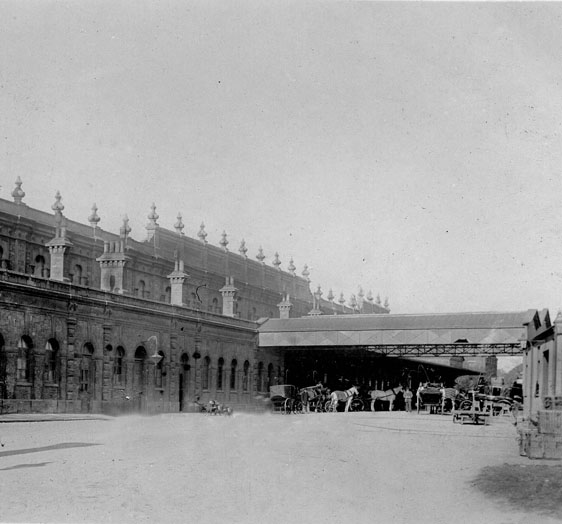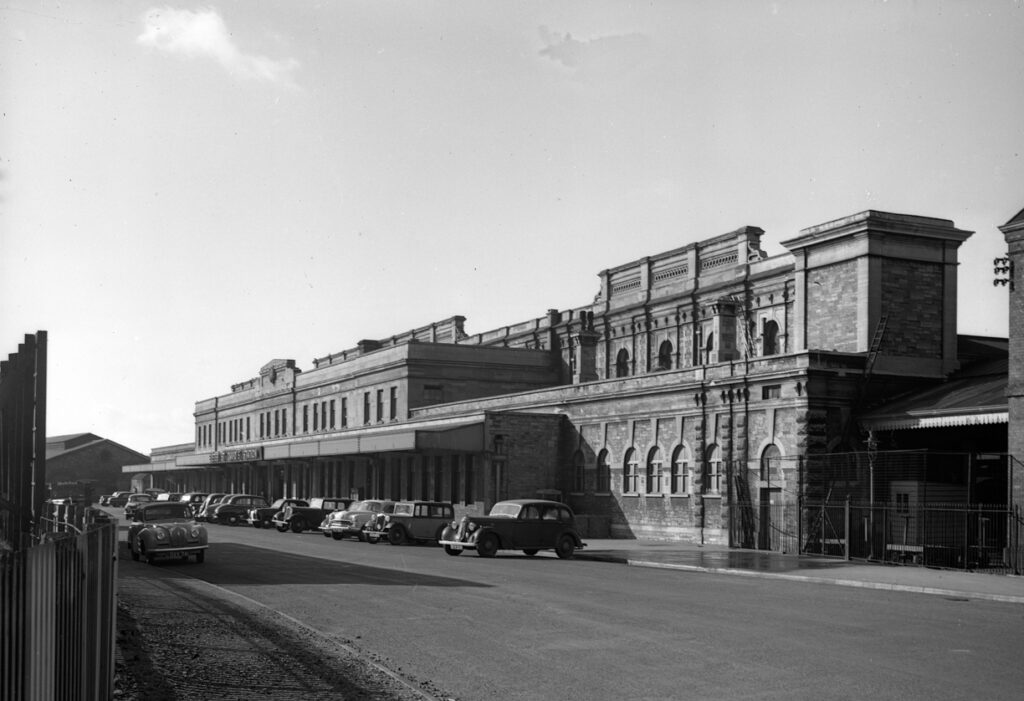Researched by Heritage Advisory Group
November 1842 ‘Bristol and Exeter Railway Terminus at Exeter. At meeting of the directors on Friday last, it was determined that the terminus the Railway at Exeter shall be on what has called the Inner Site — that is the level and spacious meadow in the occupation of Mrs Drew, dairywoman, in front of Elm Field House, St David’s, and near Tarrant’s Red Cow Inn, on the Crediton road. There is the best ground for believing that in the autumn of 1844 the entire line will be opened to Exeter.
Exeter St David’s station, which is the busiest in Devon, opened on 1st May 1844 as the terminus of the Bristol and Exeter Railway (B&ER). The guests from London for the gala opening arrived at 12.30 on schedule after a five hour journey from Paddington at an average speed of 39 miles an hour including stops.
The station was located at some distance from the city centre, because the council had refused permission for the line to cross its boundary. However, the council must have changed its mind about the benefits of train travel since it gave permission for the London and South Western Railway to run to Exeter Queen Street (now Exeter Central) in 1860, and a connection between it and St David’s was opened in 1862.

The station was designed by Isambard Kingdom Brunel and was one of his single-sided stations which meant that the two platforms were both on the east side of the line. This was the side nearer the town and convenient for passengers travelling into Exeter but did mean that a lot of trains had to cross in front of others.
This was not too much of a problem while the station was at the end of the line, but on 30th May 1846 the South Devon Railway (SDR) opened a line westwards towards Plymouth. A carriage shed was built for the SDR at the south end of the B&ER platform but the goods sheds and locomotive sheds for both companies were to the west, between the station and the River Exe. The SDR was designed to be worked by atmospheric power and an engine house was built on the banks of the river near the locomotive shed. This was only used for its original purpose for about a year but was not demolished until many years later.
The next railway to arrive at St David’s was the Exeter and Crediton Railway on 12th May 1851, the junction of which was a little distance to the north of the station at Cowley Bridge Junction
This line was worked by the B&ER and trains were accommodated at the existing platforms. All these railways had been built to the 7 ft (2,134 mm) broad gauge, but on 1 February 1862, the 4 ft 8+1⁄2 in (1,435 mm) gauge London and South Western Railway (LSWR) brought a line into the station from their own central station in Queen Street. The LSWR owned the Exeter and Crediton Railway and started to work the line for itself, although the broad gauge was retained for the B&ER to work goods trains to Crediton.
As can be imagined, with two gauges and four companies using the single-sided station, the original station of 1844 became cramped. With the additional traffic, it was in need of remodelling and reconstruction began in 1862. It was completed two years later
A new double-sided platform opened on the site west side of the line and the original up platform at the northern end was closed. The original platforms each had individual train sheds covering the tracks, and the opportunity was taken to replace these with one large train shed across all the main tracks and platforms. North of the station was a level crossing and just beyond this an additional goods shed was constructed. Unlike the earlier ones it was solely for transferring goods between the trains of the two different gauges. All of these buildings were designed by Francis Fox, the B&ER engineer, and Henry Lloyd and the work was completed in 1864.
The B&ER was amalgamated with the Great Western Railway on 1st January 1876 and the SDR did the same thing exactly one month later.
The mainline from Bristol was rebuilt with mixed gauge track that allowed broad gauge trains to run through from London Paddington railway station to Penzance, while at the same time offering a standard gauge track for local trains from Bristol Temple Meads.
The new line was ready by 1st March 1876. The train shed was removed between 1912 and 1913 and the platforms extended northwards towards the level crossing. A second island platform was provided on the west side and this entailed the goods shed being narrowed from two tracks to one at their southern end. Before Southern Region services to Plymouth were abandoned, passengers could see Plymouth-bound services of the Western Region and Southern Region leaving St David’s in opposite directions. The station has remained largely in this form since.
There are still many remains of the earlier stations to be seen. The main façade dates from 1864 and the Great Western Hotel dates from the earliest days, as does the southern section of platform 1. The goods shed opposite platform 6 shows the angle where the southern end was cut back in 1912, and at the northern end, part of the original goods shed still stands beneath later extensions. The 1864 transfer shed can still be seen beside the line beyond Red Cow Crossing; it is now a Grade II listed building.
.
.
